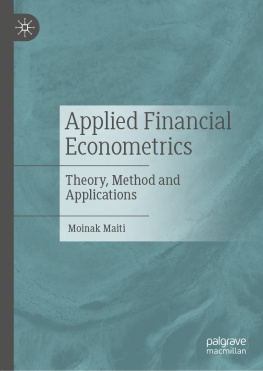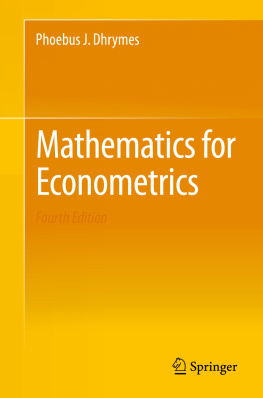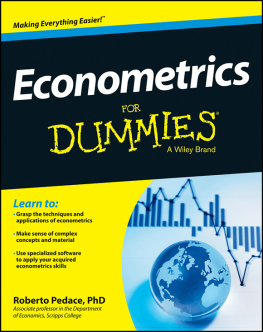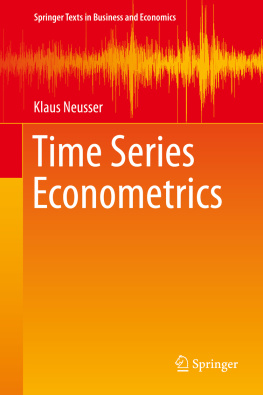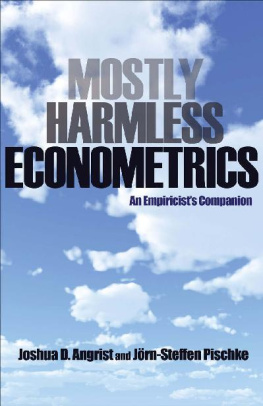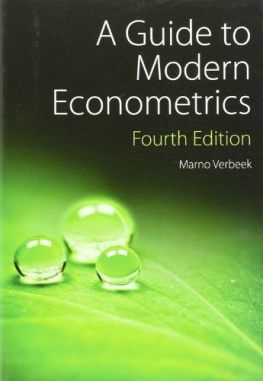Econometrics
Econometrics
FUMIO HAYASHI

Copyright 2000 by Princeton University Press
Published by Princeton University Press
41 William Street, Princeton, New Jersey 08540
In the United Kingdom: Princeton University Press, 3 Market Place,
Woodstock, OX20 1SY
All Rights Reserved
Library of Congress Cataloging-in-Publication Data
Hayashi, Fumio.
Econometrics / Fumio Hayashi.
p. cm.
Includes bibliographical references and index.
ISBN 0-691-01018-8 (alk. paper)
1. Econometrics. I. Title.
HB139.H39 2000
330.015195dc21 00034665
This book has been composed in Times Roman and Helvetica
The paper used in this publication meets the minimum requirements of
ANSI/NISO Z39.48-1992 (R 1997)
(Permanence of Paper)
www.pup.princeton.edu
Printed in the United States of America
10 9 8 7 6 5 4 3 2 1
Contents
List of Figures
Preface
This book is designed to serve as the textbook for a first-year graduate course in econometrics. It has two distinguishing features. First, it covers a full range of techniques with the estimation method called the Generalized Method of Moments (GMM) as the organizing principle. I believe this unified approach is the most efficient way to cover the first-year materials in an accessible yet rigorous manner. Second, most chapters include a section examining in detail original applied articles from such diverse fields in economics as industrial organization, labor, finance, international, and macroeconomics. So the reader will know how to use the techniques covered in the chapter and under what conditions they are applicable.
Over the last several years, the lecture notes on which this book is based have been used at the University of Pennsylvania, Columbia University, Princeton University, the University of Tokyo, Boston College, Harvard University, and Ohio State University. Students seem to like the book a lot. My own experience from teaching out of the book is that students think the book is better than the instructor.
Prerequisites
The reader of this book is assumed to have a working knowledge of the basics of calculus, probability theory, and linear algebra. An understanding of the following concepts is taken for granted: functions of several variables, partial derivatives, integrals, random variables, joint distributions, independence, unconditional and conditional expectations, variances and covariances of vector random variables, normal distributions, chi-square distributions, matrix multiplication, inverses of matrices, the rank of a matrix, determinants, and positive definite matrices. Any relevant concepts above this level will be introduced as the discussion progresses. Results on partitioned matrices and Kronecker products are collected in the appendix. Prior exposure to undergraduate econometrics is not required.
Organization of the Book
To understand how the book is organized, it is useful to distinguish between a model and an estimation procedure. The basic premise of econometrics is that economic data (such as postwar U.S. GDP) are random variables. A model is a family of probability distributions that could possibly have generated the economic data. An estimation procedure is a data-based protocol for choosing from the model a particular distribution that is likely to have generated the data. Most estimation procedures in econometrics are a specialization of the GMM estimation principle. For example, when GMM is applied to a model called the classical linear regression model, the resulting estimation procedure is Ordinary Least Squares (OLS), the most basic estimation procedure in econometrics. This viewpoint is the organizing principle in the first six chapters of the book, where most of the standard estimation procedures are presented.
The book could have presented GMM in the first chapter, but that would deprive the reader of the option to follow a series of topics specific to OLS without getting distracted by GMM. For this reason I chose to use the first two chapters to present the finite-sample and large-sample theory of OLS. GMM is presented in as a generalization of OLS.
A major expositional innovation of the book is to treat multiple-equation estimation proceduressuch as Seemingly Unrelated Regressions (SUR), Three-Stage Least Squares (3SLS), the Random-Effects method, covered in completes the books discussion of GMM by indicating how serial dependence in the error term can be incorporated in GMM.
For some models in econometrics, Maximum Likelihood (ML) is the more natural estimation principle than GMM. ML is covered in .
The book also includes an extensive treatment of time-series analysis. Basic time-series topics are covered in Section 2.2 and in the first half of . That is enough of a prerequisite for the important recent advances in nonstationary time-series analysis, which are covered in the last two chapters of the book.
Designing a Course Out of the Book
Several different courses can be designed based on the book.
Assuming that the course meets twice for an hour and a half, eight weeks should be enough to cover core theory, which is .
A twelve-week semester course can cover, in addition to the core theory, .
A short (say, six-week) course specializing in GMM estimation in cross-section and panel data would cover (excluding Section 8.7) would add the ML component to the course.
A short time-series course covering recent developments with economic applications would consist of can be dropped if the course focuses on just theory.
Review Questions and Analytical Exercises
The book includes a number of short questions for review at the end of each chapter, with lots of hints (and even answers). They can be used to check whether the reader actually understood the materials of the section. On the second reading, if not the first, readers should try to answer them before proceeding. Answers to selected review questions are available from the books website, http://pup.princeton.edu/titles/6946.html .
There are several analytical exercises at the end of each chapter that ask the reader to prove results left unproved in the text or supplementary results that are useful for their own sake. Unless otherwise indicated, analytical exercises can be skipped without loss of continuity.
Empirical Exercises
Each chapter usually has one big empirical exercise. It asks for a replication of the empirical results of the original article discussed in the applications section of the chapter and an estimation of the various extensions of the articles model using the estimation procedures presented in the chapter. The dataset for estimation, which usually is the same as the one used by the original article, can be downloaded from the books website mentioned above.
To implement the estimation procedure on the dataset, readers should run a statistical package on a computer. There are many statistical packages that are widely used in econometrics. They include GAUSS ( www.aptech.com ), MATLAB ( www.mathworks.com ), Eviews ( www.eviews.com ), LIMDEP ( www.limdep.com ), RATS ( www.estima.com ), SAS ( www.sas.com ), Stata ( www.stata.com ), and TSP ( www.tsp.com ). GAUSS and MATLAB are different from the rest in that they are matrix-based languages rather than a collection of procedures. Consider, for example, carrying out OLS with GAUSS or MATLAB. After loading the dataset into the computers workspace, it takes several lines reflecting the matrix operations of OLS to calculate the OLS estimate and associated statistics (such as
Next page

